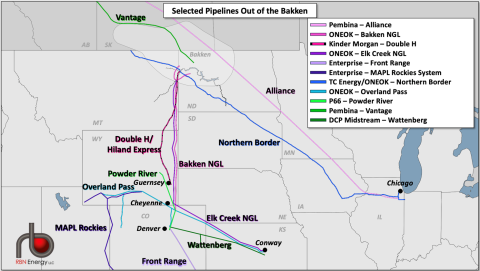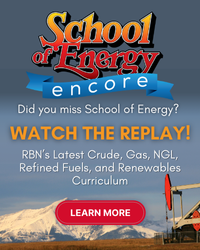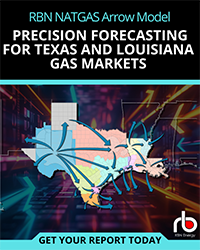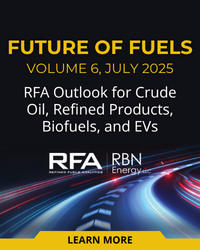Associated gas production in the Bakken Shale continues to increase and, with more NGL pipeline capacity coming online and a new option on the horizon, there’s a gunfight brewing between two of the U.S.’s largest midstreamers. At one end of a dusty Wild West street stands the sheriff in town, ONEOK, which recently completed an expansion of its Elk Creek NGL Pipeline. At the other is a renowned midstreamer from Texas, Kinder Morgan, which is staking a claim in the Rockies by converting its Double H crude oil pipeline to NGL service — renaming it Hiland Express when it does — and planning an NGL header pipeline. As we discuss in today’s RBN blog, Kinder is the first to challenge ONEOK in this space.
As in the Permian, drilling-and-completion activity in the Bakken is driven by crude oil. But also like its West Texas/Southeast New Mexico sibling, crude-focused wells in western North Dakota and the eastern edge of Montana generate massive volumes of associated gas that need to be processed (to separate natural gas from mixed NGLs) and then piped away. Last year, in Take It To The Limit, we explained that the gas-to-oil ratio (GOR) in the Bakken is now more than double what it was a decade ago. And the associated gas packs plenty of NGLs — varying widely by location but about 9 gallons per Mcf (GPM) on average. Altogether, the Bakken churns out more than 750 Mb/d of potential NGL production, about two-thirds of which is ultimately recovered, with the rest being ethane that is “rejected” into natural gas for its Btu value. (High levels of ethane rejection have raised concerns about high Btu levels in gas on Northern Border, the Bakken’s primary gas takeaway pipeline.)
There are five main ways to move NGLs out of the Bakken: (1) mixed NGLs piped south to Conway, KS, on ONEOK’s Elk Creek and Bakken NGL pipelines (medium-purple and dark-pink lines, respectively, in Figure 1 below); (2) ethane piped north to Canada on Pembina’s Vantage Pipeline (medium-green line); (3) so-called C3+ NGLs (propane, butanes and pentanes) either trucked or railed away — most ethane can’t be transported that way; (4) mixed NGLs entrained within “wet” gas on Pembina’s Alliance pipeline (light-pink line) to the Chicago area (where the NGLs are separated via fractionation); and (5) ethane rejected into gas on the Northern Border pipeline (dark-blue line).
Figure 1. Selected Pipelines Out of the Bakken. Source: RBN
Join Backstage Pass to Read Full Article








